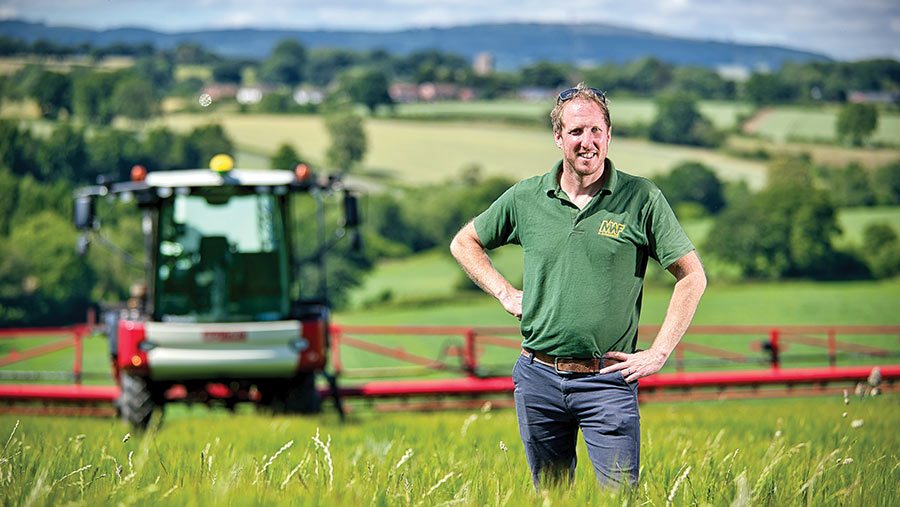Zero subsidies puts sharp focus on cost control and marketing
 Matthew Williams © Richard Stanton
Matthew Williams © Richard Stanton Arable grower Matthew Williams farms 1,100ha of rented or contract-farmed land – a situation that has brought profitability, sustainability and input cost control into sharp focus.
Shropshire-based Transition Farmer Matthew is a first generation, younger farmer who developed a passion for agriculture at school.
In 2007 he went to Harper Adams University, coming away in 2011 with a degree and a full-time tractor driver job at Criddon Hall Farm.
See also: Deadline looms for final Mid Tier CS applications
Farm facts: MW Farming, Criddon Hall Farm, Bridgnorth
- Farm size: 1,100ha
- Crops: Wheat, spring oats, spring barley, winter beans, oilseed rape, triticale
- Annual rainfall: 724mm
- Soil: Sand to a medium loamy clay
The major turning point in his career came in 2016 when the owner of the farm announced he was stepping back from farming and planned to let all of his land.
Matthew put together a robust business plan and secured backing from Lloyds Bank.
“Without the understanding and proactive support from the bank at that stage, I wouldn’t have been handed the contract for Criddon Hall and wouldn’t be where I am now,” he acknowledges.
Despite a tough first four years, Matthew has built an 1,100ha business, with several tenancies, including a 200ha stubble-to-stubble contract.
He has two permanent staff, and employs as many as five seasonal workers to cover peak periods.
Making a margin while delivering what individual client-landowners want, relies on attention to the minutest detail.
“Farming without subsidies and land-based assets as a fallback means we have to focus on every input and achieve optimal yields to make a margin,” he says.
“My big thing is cost control – the entire operation is run on a spreadsheet that I update continuously. I know 99% of my costs at any one time; I know exactly where I am each month and have identified cashflow pinch-points well ahead.”
Marketing
Matthew uses data from traders and independent analysts, including ODA Connect, and studies grain markets as often as five times a day.
Playing the market has improved returns by as much as £60,000 in one year (2018). The target is to continue refining the process to maximise grain prices and switch to reduced cultivations.
Practical farming is managed in fine detail and has continued to move towards a regen approach since 2020.
The farmed area has been mapped using Frontier’s MySoyl precision data management system.
It allows the farm and consultants to log and assess nutrient and pH profiles, along with yield data, seed-rate calculators and a mapping/recording facility for environmental work.
Matthew says this helps him better manage fuel and fertiliser use, and isolate the business from exposure to swings in prices in the future.
Transition goals
- Improve profitability and margins
- Continue to improve soil health
- Control and optimise input use
Fertiliser
Detailed soil analysis pointed to a need to exploit nutrients, such as phosphate, that were present but locked up. Applying gypsum to mobilise magnesium freed up phosphate reserves allowing lower and variable fertiliser rates.
Reducing bought-in artificial fertiliser is also the thinking behind a straw-for-manure deal with a local livestock farmer.
Although the overall aim is to be less dependent on bought-in fertiliser, gross margins are put first. Matthew will not sacrifice yield if grain prices are good, so fertiliser is still applied to maximise margins.
Yields are maintained with artificial N, but a move to liquid application is providing increased accuracy and helping to limit overall use.
Fuel
Fuel use has been cut with the switch to low-disturbance farming methods. Previously, he ploughed ahead of winter barley using about 30 litres/ha of diesel, but moving to strip-till saw a drop to 15 litres/ha.
The farm has also introduced cover crops, aided by a switch from winter to spring barley.
Some farmed areas used to suffer significant soil erosion, but the strip-till and cover crop regimes have eliminated the problem.
Soil structure has improved immensely, and areas that were previously too wet to crop have started to come to life, with worm numbers increasing.
In another bid to exploit free nutrients, the cover crops mix will be tweaked to include deep-rooting legumes and improved palatability for sheep grazing .
With structure improved, soil has reached a stage where direct drilling is achievable.
This year, the farm’s Mzuri strip-till drill has been replaced by a 6m Claydon and a second-hand John Deere 750A direct drill. It has cut fuel to 11 litres/ha, and the target now is to drop to 3.5 litres/ha.
Fewer operations means Matthew can achieve more with the same amount of machinery, spreading fixed costs over a wider area and improving the process of growing crops.
This gives MW Farming scope to tender for further blocks of land.
“Expansion is an aim, but it will only ever be through farming land to meet what the owners want and to leave the land in a better state than we found it,” he says.
